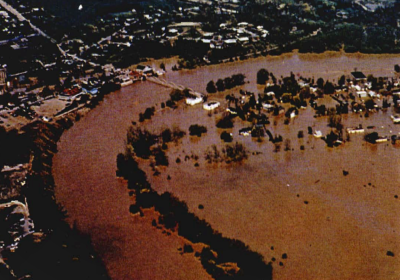The community of Bridgeport is located along the bend of the Grand River in the City of Kitchener. The former village has a history of flooding, with serious flooding reported in 1948, 1954 and 1974, when the 1950s-era earth fill dike was overtopped.
The current 1.5 km-long dike extends along the east bank of the Grand River from upstream of the Bridge Street crossing.
- The dike follows the riverbank until it turns inland, ending at Bridge Street past Schweitzer Street.
- The dike protects a mix of residential, commercial, industrial and recreational lands.
- There are municipal parks and sports fields on either side of the dike, and a trail running along the top of the dike. The sports fields behind the dike were designed to function as a stormwater detention facility to temporarily hold runoff from the lands behind the dike following a storm event.
- There are approximately 100 residential, 24 industrial, and 3 institutional buildings within the diked area.
- The original earthen dike was raised in 1980 to provide further protection from flood flows in the Grand River.
Recent studies have identified that the water levels in the Grand River would overtop parts of the dike if we were to experience flood flows that would be caused by a storm event of the same magnitude as Hurricane Hazel, which is the Regulatory Flood Event in this location. These recent engineering studies also determined that the current dike condition does not meet the design standards that are required to ensure that the dike will remain stable during the Regulatory Flood Event.




